How to Harvest Cannabis Plants: Ultimate Guide
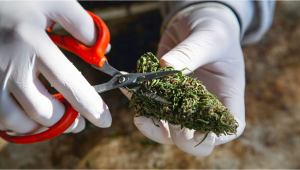
- 1. The harvest window
- 2. Contaminated flowers
- 3. Dry or wet trim?
- 3. a. Wet trimming
- 3. b. Dry trimming
- 4. Using the leftover trim
- 5. Drying and curing your trimmed weed
- 6. In conclusion
As you count down the days to harvesting, there are many things to consider in terms of preparation. Having an understanding of the harvest date, the different methods of trimming, and what to look for prior to the chop will allow you to produce the best end product possible. In this article, we explain all you need to know about harvesting, what to do with the leftover trim, and our top tips.
If you’re new to growing cannabis seeds, you probably envisioned harvest time as a period when all the work starts to wind down. You worked hard during the entire growing cycle to keep your plants fed and hydrated, and you did everything possible to minimize the risk of pests and disease. Heck, you even spend time training your plants to maximize yields and tending to your soil to ensure a healthy food web of beneficial microbes. So, now you’re probably hoping to simply enjoy the fruits (or buds) of your labor and relax. Well, you’re close to the finish line, but you’re certainly not over it. In fact, harvest time is the most crucial part of the whole cultivation process. Fumble the ball here, and you risk losing your hard-earned harvest to mold. Even if you get lucky and fungi don’t strike, you risk losing the flavor and effects of your strain of choice if you don’t cure and store your buds correctly.
1. The Harvest Window
This represents the timeframe in which Cannabis plants can be harvested. There are certain checkpoints to think about before just harvesting on a set date. Following the guided number of weeks given by the seed bank is one way to assess the harvest window, however, the following list is what a grower should use as a rule of thumb.
Under closer inspection, the color of the trichomes will indicate how mature the plants are. The appearance of the heads of the resin will be either clear, translucent, milky, silver, yellow, or amber. The more yellow and amber the trichome looks under a microscope or powerful lens will represent how the flower will be more narcotic in effect. Decide in advance what type of effect you prefer. Those who crave a heavy-bodied Indica effect would definitely like our Zkittlez Auto.
Leave her until all the trichomes are as close to amber as possible. This is when the plant produces the most desirable outcome. During the final few weeks of flowering and typically when plants are being flushed, the size and appearance of the calyx attached to the brown pistils will become swollen. As this happens, the buds will begin to take on a dense, compact, and hard to squeeze appearance. If you are not happy with the progress of your buds, then leave them in for an extra 5-7 days to give them the time. Harvesting plants too soon can be one of the biggest ways to lose final dry weight and even resin production in some cases.
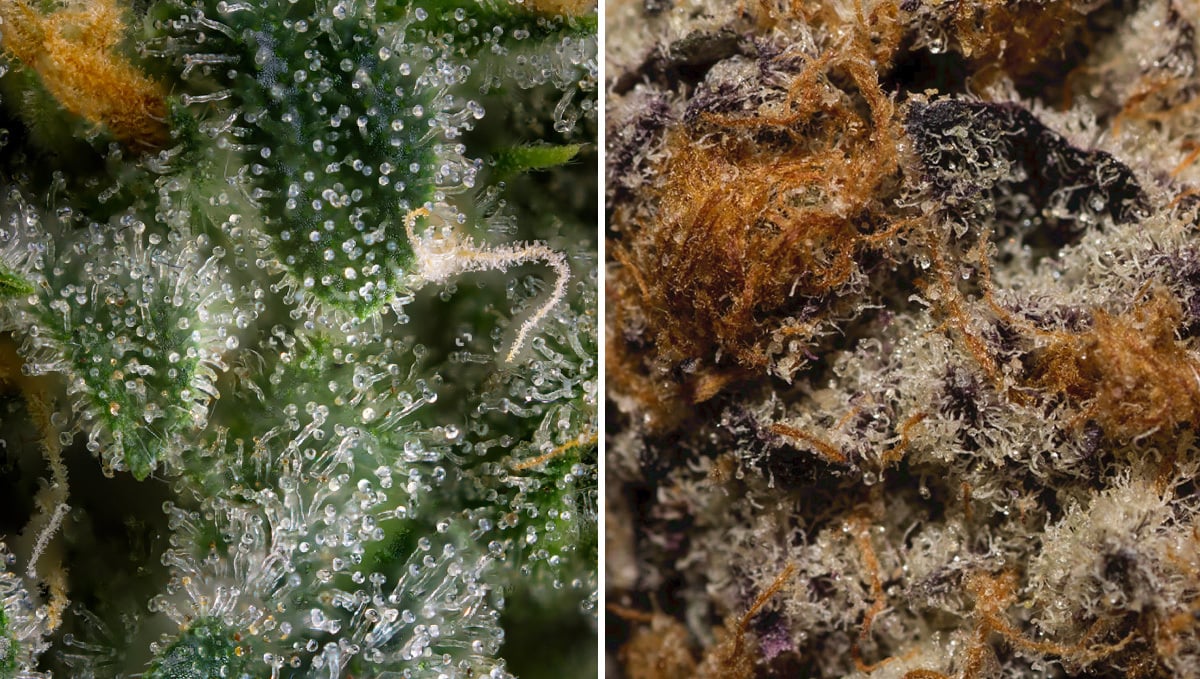
Overtime once the white pistils will have faded to a maroon, brown, they will begin to wrap themselves around the calyxes. You should never judge the maturity and ripeness of a Cannabis plant based on the percentage of brown hairs. It is better to check the ratio of brown to white hairs after inspecting the trichomes, size of buds, and are at the very end of the 14-day flushing period.
2. Contaminated Flowers
It is not always easy to inspect every plant in your grow room, and especially to find out your buds have been attacked by a pathogen late on. There are many forms of contamination ranging from pesticides, dust, and botrytis. When it comes to harvesting your fresh plants, you will want to inspect the outside and inner parts of the flowers, especially if you have grown dense and compact buds.
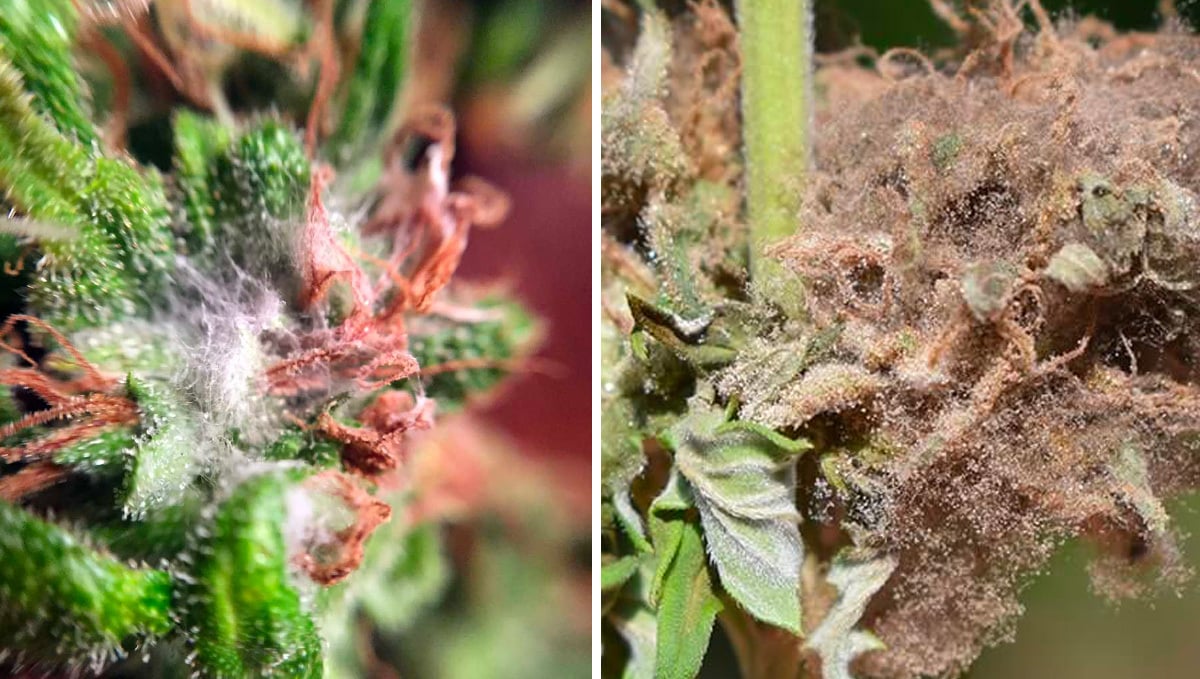
In the event that pesticides or harmful chemicals were used, you really should think twice about even wanting to smoke the flower, or make hash or extraction with. Using gloves and sterile scissors, carefully cut away any infected buds and dispose of them in the rubbish bin. As difficult as it may be having to abandon your biggest buds, smoking them will only cause more damage to your lungs and seriously affect your health.
3. Dry or Wet Trim?
Once you have chopped your ready-to-harvest plants down, you will need to decide which method of trimming you prefer. There are two ways to do this and they are known as wet and dry trimming.
Wet Trimming
This term essentially means when the plants have been freshly cut down and are wet. The trimming process actually takes place before the buds have had a chance to dry. A grower will require a drying net or mesh net screen to allow the fresh buds to air out and become dry. The buds will be cut down to a uniform size and spread out on the net. Use the sugar leaf cut from the buds to make a fresh-frozen isolator. As the buds and trim are not dry and are decarboxylated, the end product will be classed as live resin.
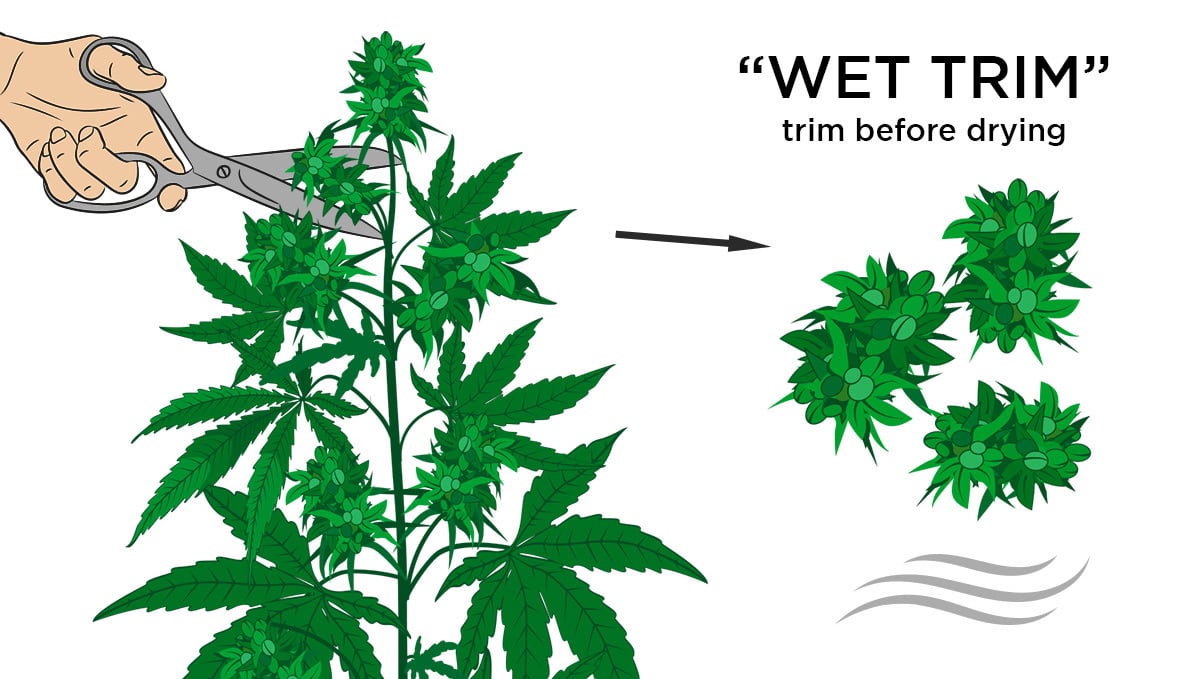
Some growers prefer to wet trim their weed because it helps to reduce the chance of mold. During the drying process, untrimmed sugar leaves can curl up against the side of the bud itself. In some cases, this can cause anaerobic pockets that are an attractive habitat for fungi—especially if you’re dealing with rather wet buds. Wet trimming also speeds up the drying process altogether by allowing water to escape from buds more quickly. Plus, it means it's smooth sailing straight to the curing stage, without any more processing required in between.
Dry Trimming
Performed once the entire plant is left to fully dry. This means all of the fan leaves and high-quality sugar trim are crisp to the touch. Commercial growers prefer this method as hand trimming freshly harvested plants can be impractical and a logistical nightmare.
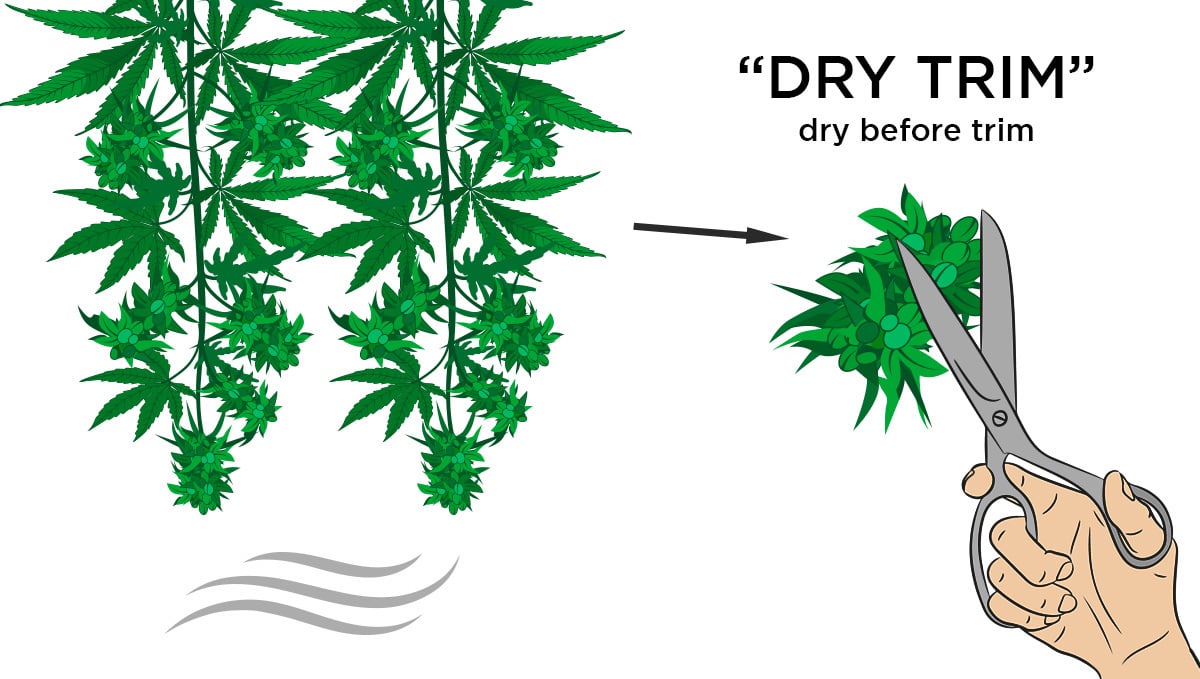
Remember it is best to remove all of the fan leaves on the plants, prior to hanging. The only leaves that should be left on to dry are the resinous ones wrapped around the buds. No matter if you are planning to wet trim or dry trim, there are some important tools that you should 100% percent consider in investing in. Many novice growers underestimate just how long it will take to trim their cannabis crop, but as any experienced cultivator will tell - it’s no small job. Professional trimmers are expected to process anywhere between 2 to 6 pounds a day, and that’s the guys and gals that have been working on commercial farms for multiple seasons. If you are new to the trimming game then we strongly suggest that you grab yourself:
- A proper set of trimming scissors
Household scissors are not designed for trimming and will make the process a hell of a lot slower and more frustrating. The last thing you want from your harvest is to be dreading the final stage, and that can definitely be the case if you don’t have the right shears.
- A trim tray
These ingenious pieces of kit can help you collect all of the unseen trichomes that will inevitably fall from your delicious buds while trimming. They work by using a micron mesh as the base of the tray that allows only the trichomes and none of the plant material through, which means you effortlessly collect all of that otherwise wasted kief which you can then turn into your favorite extract or concentrate.
4. Using The Leftover Trim
Before you throw away the leftover trim from the buds and high-grade sugar leaf, you should think about recycling the material to make either bubble hash or dry sift.
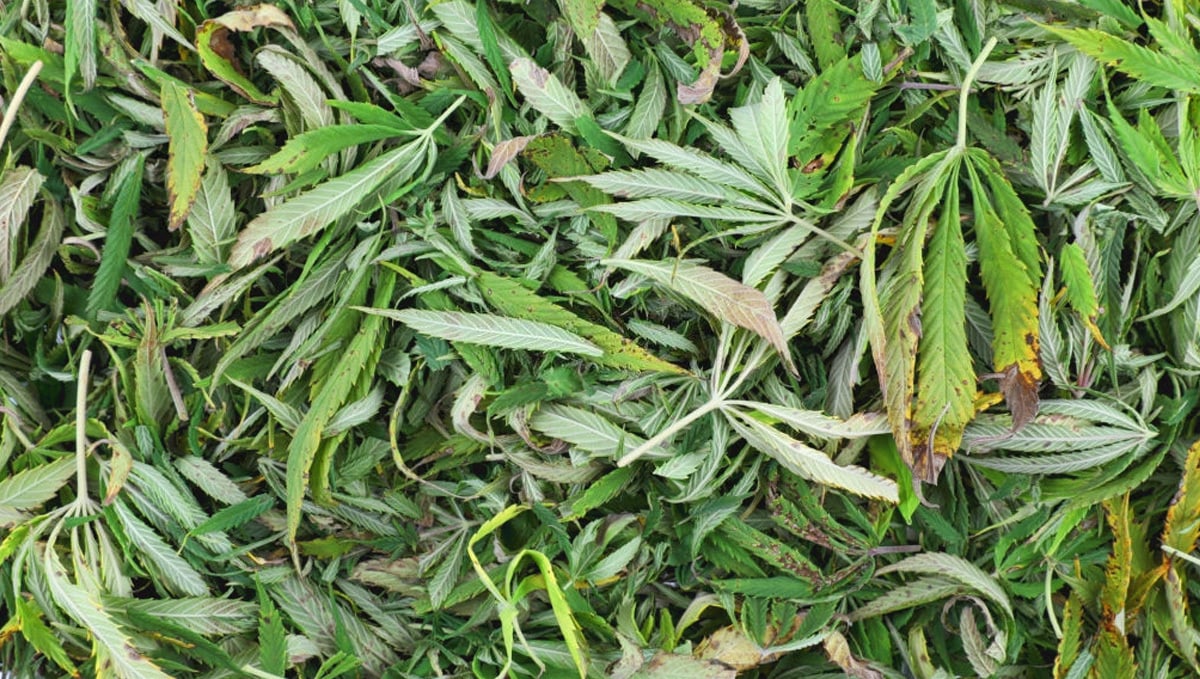
Bubble hash is made using ice, water, and various micron screen bags that will separate the trichomes from 220-45 microns. Growers who choose to wet trim their plant will enjoy making a product that is called live resin and highly sought after commercially. Dry sifting is the old-school traditional way to make a golden sandy hash. By simply rubbing your dried and decarboxylated plant material over the screen, the separation process will refine them down to a full melt, top-quality product.
5. Drying and Curing Your Trimmed Weed
An often overlooked area of growing cannabis is aftercare, in particular, the curing of the buds. Any experienced grower worth his weight will tell you the drying and curing of the buds is just as important, if not more so than the cultivation process. We won’t go too in-depth right here, but in general slower is better. Our preferred method is to cut the whole tree at the base, remove the branches and hang them separately. The dryer the ambient humidity, the more fan leaves you should leave on. If you live in a very humid area you should remove all of the fan leaves. You want the plant to dry over about a 10 to 14-day period.
Next up is curing. The general consensus these days is that curing makes up almost 50% of your final bud quality, with curing having a direct result in terpene maturity and robustness. The optimal curing temperature for most strains is around the 21-celsius mark and humidity levels of 60 to 65%. You should place your buds into a sealable glass mason jar but be sure not to overfill the jars past about 75%. For the first week you want to “burp” the jars daily, and then 3 times weekly for the next month, and finally once a week up until the 6-month point
6. In Conclusion
Make sure that you consider all of the guidelines mentioned when harvesting your plants. If you are not sure then be confident to give the plants an extra week. Harvesting plants too early can be very disadvantageous and will seriously impact the effect, terpene, trichome production, and overall dry weight. Those who don't want to waste any leftovers after harvesting would appreciate our Wedding Cheesecake Auto strain.
This highly productive hybrid will be ideal for those who want to make the top-notch quality bubble hash or extracts with the sugar trim leftovers.








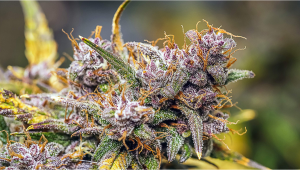


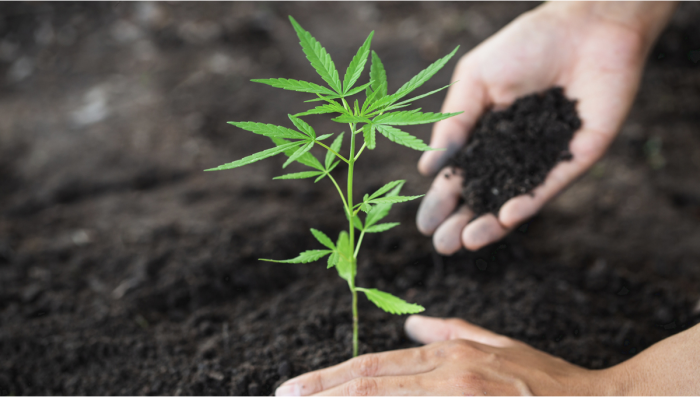
Comments